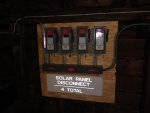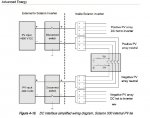shortcircuit2
Senior Member
- Location
- South of Bawstin
Installations with transformerless inverters such as the PVI 6000 TL are being installed and connected to arrays wired as a grounded system in our area.
The PV array must be wired as ungrounded or "floating"with the transformerless inverter.
This includes:
1. Not using white colored wire in string wiring.
2. Any field installed DC disconnect must break both negative and positive ungrounded conductors.
3. Any string fusing must also be in both ungrounded conductors.
4. Exposed string wiring must be PV type wire.
5. PV module whips must also be PV type wire.
The PV array must be wired as ungrounded or "floating"with the transformerless inverter.
This includes:
1. Not using white colored wire in string wiring.
2. Any field installed DC disconnect must break both negative and positive ungrounded conductors.
3. Any string fusing must also be in both ungrounded conductors.
4. Exposed string wiring must be PV type wire.
5. PV module whips must also be PV type wire.



